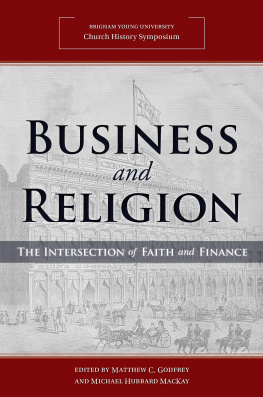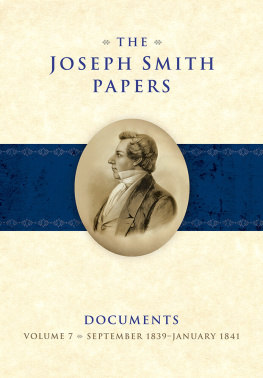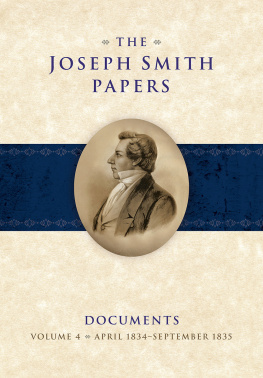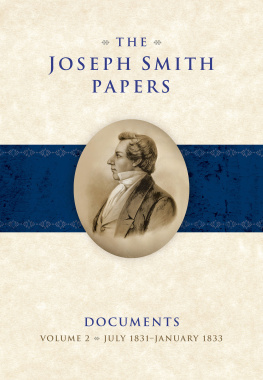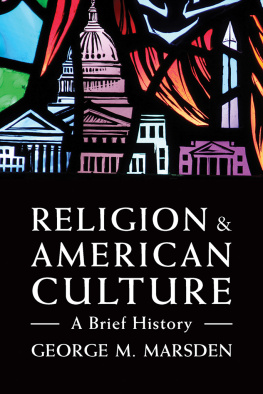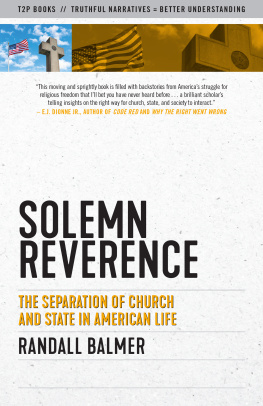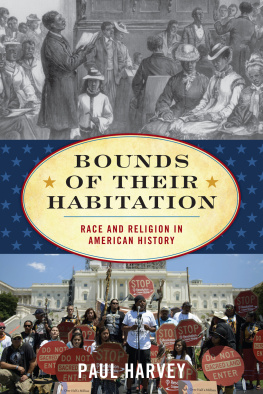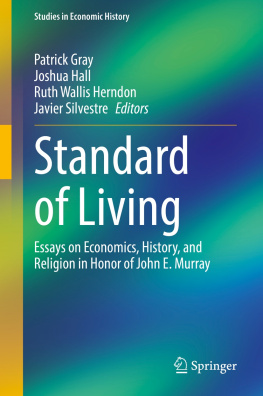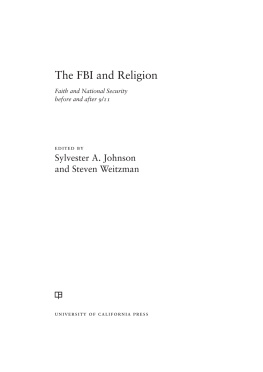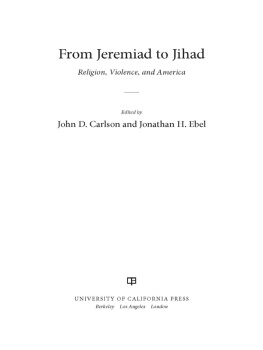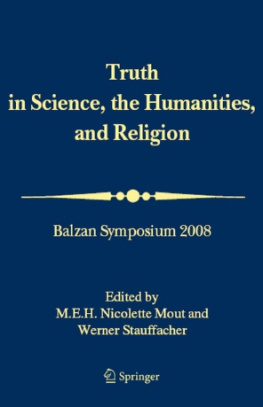Contents
Introduction
O n 12 March 2018, the Department of Religious Education at Brigham Young University and the History Department of The Church of Jesus Christ of Latter-day Saints in Salt Lake City, Utah, hosted a symposium addressing the historical intersection of business, finance, and religion within the Church. The goal of the conference was to stimulate scholarship on and thought about the economic history of the Church and to explore how financial aspects have influenced social, cultural, political, and intellectual developments in the Latter-day Saint tradition. From the papers given at that symposium, we have gathered fifteen to showcase the type of work that is ongoing in the exploration of Latter-day Saint economic history and the history of business and finance in the Church.
In our discussions of Latter-day Saint economic and financial history, welike many historians interested in the Latter-day Saint traditiontake a broad view of the topic, regarding it as a study of how economic factors, business enterprises, and financial interests affected both the Church and Latter-day Saints themselves. The studies in this volume are not statistical analyses of economic processes and methods, but are more about the ways that people and the Church itself interacted with the economy and dealt with financial interests and needs. The essays explore the ways in which money, finance, and business affected the institutional Church and the lived religion of Latter-day Saints, as well as how Latter-day Saints and the Church itself dealt with trends of financial stability and instability.
The articles in this volume build on and expand the work of other scholars, especially Leonard J. Arrington, the historian who, more than any other scholar, dominated the field of Latter-day Saint economic history in the twentieth century. In 1958 Arrington published Great Basin Kingdom: An Economic History of the Latter-day Saints, 18301900 , which set the bar for the history of economics and finance in The Church of Jesus Christ of Latter-day Saints. According to Arrington, the book was a study of Mormon concepts, and of the efforts of church leadership to develop an economy in harmony with those concepts.
With its focus on these topics and on the nineteenth century, Great Basin Kingdom defined the direction of Latter-day Saint economic history for the next several decades. Led by Arrington himself, who wrote additional studies about finances and business in the Intermountain West, much of the emphasis in economic history remained on the Great Basin in the nineteenth century.
In recent years, historians have moved outside of the focus on the economics of the institutional Church and explored the intersection of religion and economics in the lives of average Latter-day Saints. Some of this has been influenced, no doubt, by larger trends within the history of business and finance in the United States. Historians have increasingly examined how economics and business have influenced religion and religious practices, and these examinations have provided better understandings of race, gender, and ethnicity, among other things, within American religion. As one scholar has noted, looking at the intersection of economics and religion allows historians in a given place and time to rethink what is going on in a broad sweep of the American religious experience.
In similar ways, recent articles and books have explored how economics and finance have influenced average Latter-day Saints in their lives. Building on the work of Thomas G. Alexander in his groundbreaking book Mormonism in Transition , which included a chapter on the transformation of the Latter-day Saint temporal kingdom from 1890 to 1930, Ethan Yorgason examined the cultural transformations that occurred among Latter-day Saints as the Church moved away from cooperation and self-sufficiency and into the national capitalist economy at the turn of the twentieth century. He argued that the major turn-of-the-century change was the acceptance of Church members of capitalist cultural logic, including embracing individualism over communitarianism.
Yet studies of the institutional Churchs involvement in business and finance have still been important. Garth Mangum and Bruce D. Blumell, for example, produced an important study in 1993 on how the Church had attempted to take care of the poor and the needy since its establishment, especially focusing on the development of the welfare program in the twentieth century.
The work of the historians showcased in this volume indicate the type of scholarship that can be done on all of these topics. In terms of individual Church members, Brooke Kathleen Brassard examines how Latter-day Saint farmers in Alberta, Canada, in the early twentieth century embraced political organizations such as the United Farmers of Alberta, which criticized capitalism and promoted cooperation at a time when Saints in Utah were turning more toward capitalism and away from cooperation. Brian Q. Cannon, meanwhile, explores what we can learn about private wealth and financial networks in Latter-day Saint society from a list compiled by the Presiding Bishopric in 1918 of individuals who paid more than $1,000 in tithing.
Another field that is ripe for harvesting is the role of women and ethnic groups in economic life. Four essays in this volume explore aspects of this topic, including Patricia Lemmon Spilsburys examination of the financial contributions that women made to their families and communities through the straw-braiding industry, a topic on which little has previously been written. Mary Jane Woodger and Kiersten Robertson look at a similar theme in the twentieth century, investigating ways that women raised money for the construction of a Relief Society building in the 1940s. Sherilyn Farnes examines the economic experiences Eliza and Caroline Partridge had as plural wives of Amasa Lyman, including their financial struggles. Farnes uses the Partridge sisters as a case study for the economic impact of plural marriage on individuals in Utah, thereby augmenting general studies on plural marriage conducted by Kathryn Daynes, Jessie Embry, and Laurel Thatcher Ulrich, among others. Finally, Julie K. Allen examines the life of Hans Jrgenson, a Danish immigrant to Utah, to explore how those who converted to the Church outside of the United States and migrated to Utah faced economic struggles that at times conflicted with their goal of spiritual redemption. These four essays show the insights that can be gained into the lives of Latter-day Saint women and ethnic groups by examining their financial situations and contributions to community and family economics.
Other articles convey additional insights into the Church itself. Gerrit Dirkmaat looks at two early attempts to live the law of consecration and how these failed efforts convinced Church leaders of the necessity of obtaining deeded titles to consecrated land. Samuel D. Brunson depicts the Churchs battle with the federal government in the 1870s over whether it needed to pay income tax, using this conflict to show that, unlike the battles the Church had with the federal government over plural marriage, Church leaders engaged with government officials in productive ways in order to reach an acceptable solution. Joseph F. Darowski examines the development of the Church Security Plan by Church leaders in the 1920s and 1930s, describing it as a continuation of the Churchs concern for the poor and needy and a forerunner of the welfare program, while Scott C. Esplin looks at both the philosophies Church leaders had about the need to educate Latter-day Saint youth and the economic realities that complicated the implementation of these philosophies. These essays clearly indicate that there is much still to explore in regard to finance and the institutional Church.

